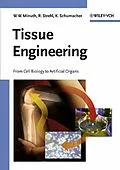Mit Hilfe des 'Tissue Engineering' konnten in den vergangenen zehn Jahren große Fortschritte bei der Züchtung von künstlichem Gewebe erzielt werden. Künstliche Gewebe werden heute bereits zum Ersatz verbrannter Hautbereiche z.B. in der plastischen Chirurgie oder zum Aufbau verletzter Knorpelstrukturen eingesetzt.
Dieses besonders umfangreich und anschaulich illustrierte Praktikerbuch vermittelt die grundlegenden Einblicke in die komplexe Welt der Gewebeentstehung und der Züchtung von künstlichem Gewebe mit Hilfe des 'Tissue Engineering'.
Einführend werden die Grundlagen der Zellbiologie und Gewebeentstehung und des weiteren der Gewebezüchtung behandelt. Ein besonderes Augenmerk legen die Autoren auf die Mechanismen der Gewebedifferenzierung und die kritische Bewertung von Eigenschaften in reifenden Gewebekonstrukten. Gesicherte therapeutische Erfolge beim 'Tissue Engineering' werden nur dann erzielt, wenn die reifenden Gewebekonstrukte zuverlässig die gewünschten funktionellen Eigenschaften entwickeln.
Ein zweiter Schwerpunkt dieses Buches liegt auf der Anwendung von Stammzellen unterschiedlichster Herkunft beim 'Tissue Engineering'. Es reicht nicht aus, Stammzellen zu isolieren und zu vermehren, vielmehr müssen daraus sorgfältig gesteuert funktionelle Gewebe entwickelt werden.
Abgerundet wird dieses Buch durch ein außergewöhnlich umfangreiches Glossar, das rund 1000 Stichwörter aus Zellbiologie, Gewebekulturtechnik und 'Tissue Engineering' enthält.
Autorentext
Will W. Minuth has been Professor for Anatomy at the University of Regensburg since 1989; Philip Morris Research Prize "Challenge of the Future" in 1992 for his development of an innovative cell culture system; co-founded Minucells and Minutissue GmbH in 1993; member of the German Academy for Transplantation Medicine; currently developing new strategies for the manufacture of tissue constructs; and expert advisor to international research projects in the field of tissue engineering.
Raimund Strehl began studying biology at the University of Regensburg and Arizona State University, Arizona in 1988; doctorate at the University of Regensburg from 1997 onwards; began postdoc at the Sahlgrenska Sjuikhuset, Gothenburg; and at the Anatomical Institute of the University of Regensburg in 2000.
Karl Schumacher started studying human medicine at Bonn University in 1985; doctorate in 1993 at the Pathological Institute in Bonn; from 1993 onwards intern at the Urological Clinic and Children's Urological Clinic of Bonn University and the surgical unit of the teaching hospital in Mechenich; since 1998 scientist at the Anatomic Institute of the University of Regensburg.
Klappentext
Comprehensive in its scope and illustrated in detail, this practical book provides a fundamental insight into the complex world of tissue development and artificial cell culture using tissue engineering.
The introductory chapters cover basic cell biology and cellular development as well as cell culture, with a main emphasis on ways of differentiating tissue and the critical evaluation of the properties of maturing tissue constructs. The authors also focus on the use of stem cells from the most varied sources in tissue engineering.
The whole is rounded off by an exceptionally wide-ranging glossary containing some 1,000 key words from the fields of cell biology, cell culture development and tissue engineering.
Inhalt
Preface V
1 Developmental processes 1
2 Cells and Tissue 4
2.1 The Cell 4
2.1.1 The Cell as a Functional Unit 4
2.1.2 Plasma Membrane 5
2.1.3 Nucleus 6
2.1.4 Mitochondria 6
2.1.5 Endoplasmic Reticulum (ER) 6
2.1.6 Golgi Apparatus 7
2.1.7 Endosomes, Lysosomes and Peroxisomes 7
2.1.8 Cytoskeleton 8
2.1.9 ECM 8
2.1.10 Cell Cycle 9
2.2 Tissue Types 10
2.2.1 Epithelia 10
2.2.1.1 Building Plans of Epithelia 11
2.2.1.2 Glands 14
2.2.1.3 Epithelia in Sensory Perception 16
2.2.2 Connective Tissue 17
2.2.2.1 Variety 18
2.2.2.2 Fat Tissue as Storage 20
2.2.2.3 Bone and Cartilage as Support Tissue 21
2.2.3 Muscle Tissue 26
2.2.3.1 Cell Movement 26
2.2.3.2 Rhythmic Contraction 28
2.2.3.3 Unconscious Contraction 29
2.2.4 Nervous System Tissue 31
2.2.4.1 Information Mediation 31
2.2.4.2 Networks and Connections 33
2.3 Relevance of the ECM 35
2.3.1 Components of the ECM 35
2.3.1.1 Functions of the ECM 35
2.3.1.2 Synthesis of the Collagens 37
2.3.1.3 Fibronectin 38
2.3.1.4 Laminin 39
2.3.1.5 Reticular and Elastic Fibers 39
2.3.1.6 Collagens of the Basement Membrane 39
2.3.1.7 FACIT Collagens 40
2.3.1.8 Proteoglycans 40
2.3.2 Interactions between the Cell and the ECM 41
2.3.2.1 Adhesion and the ECM 41
2.3.2.2 Proliferation and the ECM 41
2.3.2.3 Differentiation and the ECM 42
2.3.2.4 Apoptosis and the ECM 43
2.3.3 Signal Transduction 43
2.3.3.1 Modulation of the CellMatrix Interaction 43
2.3.3.2 The ECM and Cell Binding 44
2.3.3.3 Signals to the Inner Cell 47
2.3.3.4 The ECM and Long-term Contact 48
2.3.4 Matricellular Proteins 51
2.3.4.1 Thrombospondin 52
2.3.4.2 Tenascin C 52
2.3.4.3 Osteopontin 52
2.3.4.4 SPARC 53
2.4 Emergence of Tissue 53
2.4.1 Germ Layers and Ground Tissue 53
2.4.1.1 Derivatives of the Ectoderm 55
2.4.1.2 Derivatives of the Mesoderm 56
2.4.1.3 Derivatives of the Entoderm 58
2.4.2 Individual Cells, Social Interactions and Functional Tissue Development 58
2.4.2.1 Differentiation from Individual Cells 59
2.4.2.2 Functional Exceptions 60
2.4.2.3 Individual Cells and Social Interactions 60
2.4.2.4 Formation of tissue 61
2.4.2.5 Individual Cell Cycles 66
2.4.2.6 Coordinated Growth 67
2.4.2.7 Competence 67
2.4.2.8 Morphogenic Factors 68
2.4.2.9 Apoptosis 69
2.4.2.10 Necrosis versus Apoptosis 71
2.4.2.11 Terminal Differentiation 71
2.4.2.12 Adaptation 72
2.4.2.13 Transdifferentiation 73
2.4.2.14 Multifactorial Differentiation 73
2.5 Regeneration 74
2.5.1 Events Immediately after an Injury 74
2.5.2 Wound Closure 75
2.5.3 Programmed Cell Death (Apoptosis) 75
2.5.4 Cooperative Renewal 76
3 Classical Culture Methods 78
3.1 History 78
3.2 First Cultures 79
3.2.1 Culture Containers 80
3.2.1.1 Individual Culture Containers 80
3.2.1.2 Dimensions of the Container 81
3.2.1.3 Coating the Culture Dish 81
3.2.1.4 Filter Inserts 82
3.2.2 Culture Media 82
3.2.2.1 Ingredients 84
3.2.2.2 Adjustment of Serum Supplements 86
3.2.2.3 Serum Collection 87
3.2.2.4 Serum-free Culture Media 88
3.2.2.5 pH of the Medium 90
3.2.2.6 Antibiotics 90
3.2.2.7 Other Additives 91
3.2.3 Growth Factors 92
3.2.3.1 Overview of Different Growth Factors 92
...
